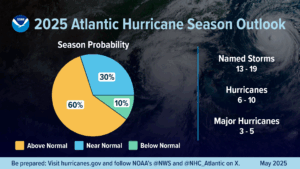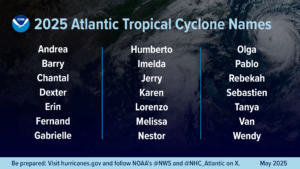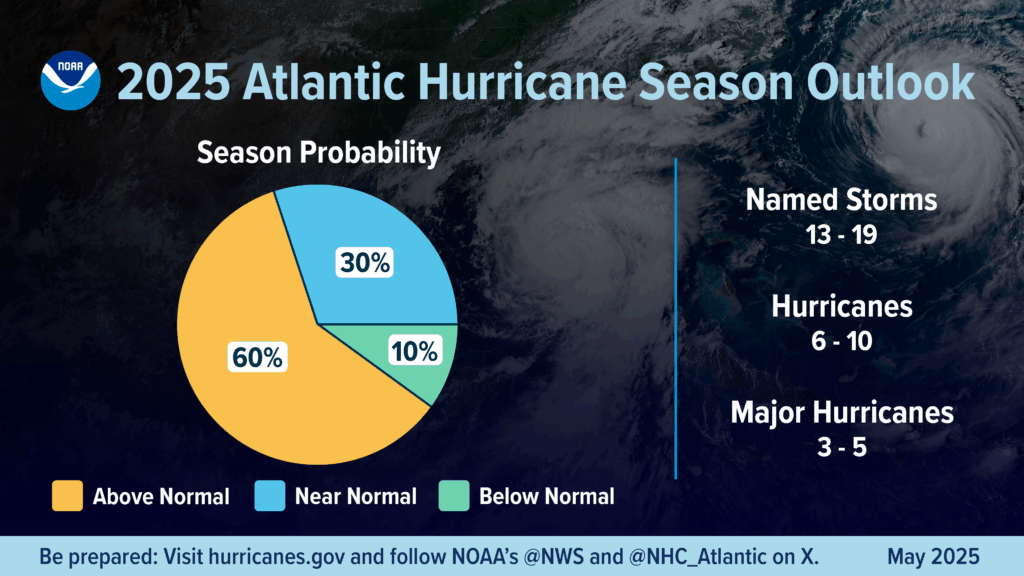It’s that time of year, hurricane season is upon us. From June 1 to November 30 each year, we brace for hurricanes. As last year showed us, it is not always coastal communities that are impacted by hurricanes.
Forecasters within NOAA’s National Weather Service predict above-normal hurricane activity in the Atlantic basin this year. The agency is forecasting a range of 13 to 19 total named storms (winds of 39 mph or higher). Of those, 6-10 are forecasted to become hurricanes (winds of 74 mph or higher), including 3-5 major hurricanes (category 3, 4, or 5; with winds of 111 mph or higher). NOAA has a 70% confidence in these ranges.

Know Your Risks
Now is a good time to check out potential risks where you live. Are there wind and water hazards that could happen where you live? Know if you live in an area prone to flooding, if you live in an evacuation zone, and identify any structural weaknesses in your home.
Storm surge, flooding, hurricane-force winds, tornadoes, rip currents, and rough surf can all be potential problems during a hurricane. Do you live in a flood-prone area? Here are two resources for you to check: Floodsmart.gov: Understanding Flood Zones and NOAA’s Coastal Flood Exposure Mapper
Here are two resources to check if you live in a storm surge evacuation zone: HurricaneStrong: Find Your Evacuation Zoneoffsite link, Know Your Zone NC: Learn Established Evacuation Zones For Eastern North Carolina and NHC Storm Surge Hazard Maps. Knowing this information is helpful when you draft your evacuation plan.
Preparation
Getting ready involves preparing your home, car, you/your family, and your pets. Let’s take these one at a time!
Your Home
- Keep drains and gutters free of debris and clutter
- Clear easily blown items from your surroundings
- Install check valves in your plumbing to prevent backups
- Board up or use hurricane shutters on your windows
- Review your insurance policies and have them accessible
Your Car
- An Emergency Kit in your car
- Keep your gas tank filled
- Flares and matches
- Lantern
- Physical maps
- Jumper cables
- Extra cans of gas
- Warm blanket(s)
- Water and snacks
For You and Your Family
- Communication plan for your family
- Picture ID’s
- Water — one gallon of water per person per day for at least three days
- Food — at least three days worth of non-perishable foods
- Battery-powered radio and/or a NOAA Weather Radio with tone alert
- Flashlight
- First aid kit
- Extra batteries
- Whistle to signal for help
- Face masks
- Dust mask to help filter contaminated air, plastic sheeting, and duct tape to shelter in place
- Moist towelettes, garbage bags, and plastic ties
- Wrench or pliers to turn off utilities
- Manual can opener for food
- Local maps and evacuation routes
- Cell phone with chargers and a backup battery
- Prescription medications
- Non-prescription medications such as pain relievers, anti-diarrhea medication, antacids or laxatives
- Glasses, contact lens, and cleaning solution
- Infant formula, bottles, diapers, wipes, diaper rash cream
- Pet food and extra water for pets
- Cash
- Sleeping bag or warm blankets
- Changes of clothing and sturdy shoes
- Household chlorine bleach and medicine dropper to disinfect water
- Fire extinguisher
- Matches in a waterproof container
- Personal hygiene items
- Paper cups, plates, paper towels, and plastic utensils
- Paper and writing utensils
- Books, games, puzzles or other activities
For Pets
- Food. At least a three-day supply in an airtight, waterproof container.
- Water. At least three days of water specifically for your pets.
- Medicines and medical records. Most boarding kennels, veterinarians and animal shelters will need your pet’s medical records to make sure all vaccinations are current.
- Important documents. Registration information, adoption papers and vaccination documents. Talk to your veterinarian about microchipping and enrolling your pet in a recovery database.
- First aid kit. Cotton bandage rolls, bandage tape and scissors; antibiotic ointment; flea and tick prevention; latex gloves, isopropyl alcohol and saline solution. Including a pet first aid reference book is a good idea too.
- Collar or harness with ID tag, rabies tag and a leash.
- Crate or pet carrier. Have a sturdy, safe crate or carrier in case you need to evacuate. The carrier should be large enough for your pet to stand, turn around and lie down.
- Sanitation. Pet litter and litter box if appropriate, newspapers, paper towels, plastic trash bags and household chlorine bleach.
- A picture of you and your pet together. If you become separated, a picture of you and your pet together will help you document ownership and allow others to assist you. Add species, breed, age, sex, color and distinguishing characteristics.
- Familiar items. Familiar items, such as treats, toys and bedding can help reduce stress for your pet.

Consistent Steps
Small, consistent steps in your planning and preparation process lead to big results! This applies to preparation in advance of all natural disasters: hurricanes, tornadoes, flooding, hail, lightening strikes, fires, earthquakes, power outages, monsoons, typhoons, and volcanic eruptions.
We typically plan for what is known where you live. Yet, if last year taught us anything, let it be this. Preparation goes a long way whenever anything crosses our path.
It’s no fun after a storm to wish you had made time in advance to prepare. Small, consistent steps along the way allows you to focus on the situation at hand and be fully present every day.
I’m happy to be a part of your advanced planning team. Send me an Email or Book Time with Lynn if I may be of help. For additional information about my work, check out @ The Living Planner or @ The Living Planner.
If you’re up for planning your life’s administrative side, consider my book as a resource. The Living Planner: What to Prepare Now While You Are Living © Check it out HERE.
Quote for the week: “Keep your face always toward the sunshine and shadows will fall behind you.” – Walt Whitman
Enjoy the sunshine 🌞 Lynn
#PlanfortheUnplanned #Can’tPredictCanPrepare

